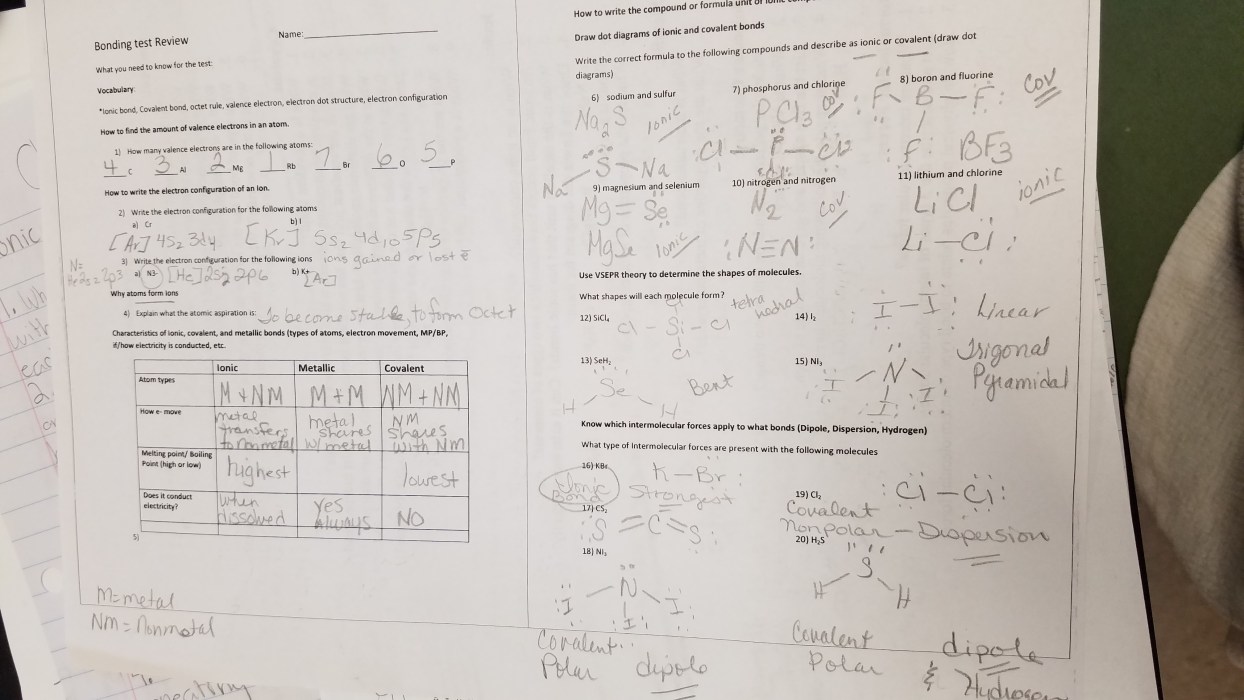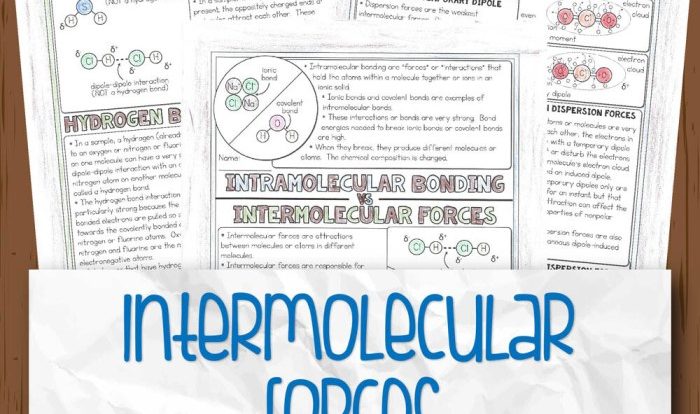Unit 6 Chemical Bonding Test Review: A Comprehensive Guide provides a thorough overview of the fundamental concepts of chemical bonding, equipping readers with the knowledge and understanding necessary to excel in their chemistry studies.
This review covers a wide range of topics, including the basics of chemical bonding, the different types of chemical bonds, and their applications in various fields.
Chemical Bonding Basics

Chemical bonding refers to the attractive forces that hold atoms together to form molecules or crystals. These forces arise from the electrostatic interactions between positively charged atomic nuclei and negatively charged electrons.
Types of Chemical Bonds
There are three main types of chemical bonds:
- Covalent Bonds:Formed when atoms share electrons to achieve a stable electron configuration.
- Ionic Bonds:Formed when one atom transfers electrons to another, creating oppositely charged ions that attract each other.
- Metallic Bonds:Formed in metals, where electrons are delocalized and can move freely throughout the metal lattice.
Factors Influencing Bond Strength
The strength of a chemical bond depends on several factors:
- Bond Length:Shorter bond lengths indicate stronger bonds.
- Bond Order:Bonds with higher bond orders (number of shared electron pairs) are stronger.
- Electronegativity Difference:Bonds between atoms with large electronegativity differences tend to be more ionic and stronger.
- Bond Polarity:Polar bonds, where electrons are not shared equally, can be weaker than nonpolar bonds.
Types of Chemical Bonds
Chemical bonds are the forces that hold atoms together to form molecules and compounds. There are four main types of chemical bonds: ionic, covalent, metallic, and hydrogen bonds.
Ionic Bonds
Ionic bonds are formed between atoms of metals and nonmetals. In an ionic bond, one atom transfers one or more electrons to another atom, creating two oppositely charged ions. The positive ion is attracted to the negative ion, forming an ionic bond.
For example, sodium (Na) and chlorine (Cl) can form an ionic bond. Sodium has one valence electron, which it is willing to give up. Chlorine has seven valence electrons, and it needs one more electron to complete its valence shell.
When sodium gives up its valence electron to chlorine, sodium becomes a positive ion (Na+) and chlorine becomes a negative ion (Cl-). The oppositely charged ions are attracted to each other, forming an ionic bond.
Covalent Bonds
Covalent bonds are formed between atoms of nonmetals. In a covalent bond, the atoms share one or more pairs of electrons. The shared electrons are attracted to the nuclei of both atoms, forming a covalent bond.
For example, hydrogen (H) and chlorine (Cl) can form a covalent bond. Hydrogen has one valence electron, and chlorine has seven valence electrons. When two hydrogen atoms share their valence electrons, they form a covalent bond. The shared electrons are attracted to the nuclei of both hydrogen atoms, forming a covalent bond.
Metallic Bonds, Unit 6 chemical bonding test review
Metallic bonds are formed between atoms of metals. In a metallic bond, the metal atoms share their valence electrons in a sea of electrons. The valence electrons are not attached to any particular atom, but they are free to move around the metal.
The sea of electrons holds the metal atoms together, forming a metallic bond. Metallic bonds are very strong, which is why metals are strong and ductile.
Hydrogen Bonds
Hydrogen bonds are formed between a hydrogen atom and an electronegative atom, such as oxygen, nitrogen, or fluorine. In a hydrogen bond, the hydrogen atom is covalently bonded to one atom and forms a dipole with another atom.
The dipole is created because the electronegative atom pulls the electrons in the covalent bond towards itself, creating a partial positive charge on the hydrogen atom and a partial negative charge on the electronegative atom. The partial positive charge on the hydrogen atom is attracted to the partial negative charge on the electronegative atom, forming a hydrogen bond.
Hydrogen bonds are weaker than ionic, covalent, and metallic bonds, but they are important in many biological systems, such as DNA and proteins.
Bonding in Molecules
Atoms interact with each other to form molecules through chemical bonding. This process involves the sharing or transfer of electrons between atoms, resulting in the formation of stable molecular structures.
One fundamental concept in understanding bonding in molecules is electronegativity. Electronegativity refers to the ability of an atom to attract electrons towards itself. The more electronegative an atom, the stronger its pull on shared electrons.
Types of Molecular Structures
The arrangement of atoms within a molecule is known as its molecular structure. Different types of molecular structures exist, including:
- Linear:Atoms are arranged in a straight line.
- Bent:Atoms are arranged in a V-shape.
- Trigonal Planar:Atoms are arranged in a flat, triangular shape.
- Tetrahedral:Atoms are arranged in a three-dimensional, tetrahedral shape.
Role of Electronegativity in Bonding
Electronegativity plays a crucial role in determining the type of chemical bond formed between atoms. When two atoms with similar electronegativity bond, they form a covalent bond, where electrons are shared equally between the atoms.
In contrast, when two atoms with significantly different electronegativity bond, they form an ionic bond, where one atom transfers electrons to the other, resulting in the formation of oppositely charged ions.
Electronegativity values range from 0 to 4, with fluorine being the most electronegative element and cesium being the least electronegative.
Bonding in Solids: Unit 6 Chemical Bonding Test Review

Solids are characterized by their rigid structure and definite shape and volume. The strong forces of attraction between the constituent particles in solids account for these properties. The type of bonding in a solid determines its physical and chemical properties.
Ionic Bonding
Ionic bonding involves the electrostatic attraction between positively charged ions (cations) and negatively charged ions (anions). In solids with ionic bonding, the ions are arranged in a regular lattice structure, with cations surrounded by anions and vice versa. This arrangement results in a strong electrostatic attraction that holds the ions together.
Solids with ionic bonding typically have high melting and boiling points, as well as good electrical conductivity when dissolved in water. Examples of ionic solids include sodium chloride (NaCl), potassium chloride (KCl), and calcium oxide (CaO).
Covalent Bonding
Covalent bonding involves the sharing of electrons between atoms. In solids with covalent bonding, the atoms are linked together by covalent bonds, forming a network of interconnected atoms. This type of bonding is typically found in non-metals and results in solids with low melting and boiling points, as well as poor electrical conductivity.
Examples of covalent solids include diamond (carbon), graphite (carbon), and quartz (silicon dioxide).
Metallic Bonding
Metallic bonding involves the attraction between positively charged metal ions and the surrounding sea of mobile electrons. In solids with metallic bonding, the metal ions form a regular lattice structure, while the electrons are free to move throughout the solid.
This type of bonding results in solids with high melting and boiling points, as well as good electrical and thermal conductivity. Examples of metallic solids include copper, aluminum, and iron.
Van der Waals Bonding
Van der Waals bonding involves weak attractive forces between nonpolar molecules or atoms. These forces arise from temporary fluctuations in electron distribution, resulting in the formation of instantaneous dipoles. The strength of van der Waals bonding is relatively weak compared to ionic, covalent, and metallic bonding.
Solids with van der Waals bonding typically have low melting and boiling points, as well as poor electrical and thermal conductivity. Examples of solids with van der Waals bonding include noble gases (e.g., helium, neon), molecular crystals (e.g., sugar, iodine), and organic compounds.
Bonding in Liquids
In liquids, molecules are held together by intermolecular forces, which are weaker than the intramolecular forces that hold atoms together within a molecule. These intermolecular forces can be of various types, including van der Waals forces, dipole-dipole interactions, and hydrogen bonding.
The strength of the intermolecular forces in a liquid determines its physical properties, such as boiling point, melting point, and viscosity. Liquids with strong intermolecular forces, such as hydrogen bonding, have higher boiling points and melting points than liquids with weaker intermolecular forces, such as van der Waals forces.
Types of Intermolecular Forces
- van der Waals forcesare weak attractive forces that occur between all molecules. They are caused by the temporary fluctuations in the electron distribution of molecules, which create instantaneous dipoles.
- Dipole-dipole interactionsare attractive forces that occur between polar molecules, which have a permanent dipole moment. The positive end of one molecule is attracted to the negative end of another molecule.
- Hydrogen bondingis a strong attractive force that occurs between molecules that contain a hydrogen atom bonded to a highly electronegative atom, such as oxygen, nitrogen, or fluorine. The hydrogen atom in these molecules has a partial positive charge, which is attracted to the partial negative charge on the electronegative atom of another molecule.
Examples of Liquids with Different Bonding Characteristics
- Wateris a liquid with strong hydrogen bonding. It has a high boiling point (100 °C) and a high melting point (0 °C).
- Alcoholis a liquid with dipole-dipole interactions. It has a lower boiling point (78 °C) and a lower melting point (-114 °C) than water.
- Hexaneis a liquid with van der Waals forces. It has a low boiling point (69 °C) and a low melting point (-95 °C).
Bonding in Gases
Gases are characterized by their low density and high fluidity, and their constituent particles are widely spaced apart. The bonding in gases is typically weak, and the particles move freely with high kinetic energy. The nature of bonding in gases significantly influences their properties and behavior.
Types of Bonding in Gases
- Covalent Bonding:In covalent gases, atoms share electrons to form stable molecules. Examples include hydrogen (H2), chlorine (Cl2), and carbon dioxide (CO2).
- Ionic Bonding:Ionic gases consist of positively charged ions (cations) and negatively charged ions (anions) held together by electrostatic forces. An example is sodium chloride (NaCl) in the gas phase.
- Metallic Bonding:Metallic gases are formed by metal atoms that share their valence electrons in a “sea of electrons.” This type of bonding results in high electrical and thermal conductivity. An example is mercury vapor (Hg).
- van der Waals Bonding:van der Waals gases are nonpolar molecules that interact through weak intermolecular forces, including dipole-dipole interactions and London dispersion forces. Examples include noble gases (e.g., helium, neon).
Relationship between Bonding and Properties of Gases
The type of bonding in gases has a direct impact on their physical and chemical properties:
- Boiling Point:Gases with strong covalent bonds, such as hydrogen and chlorine, have higher boiling points than gases with weaker van der Waals bonds, such as helium and neon.
- Solubility:Gases with polar covalent bonds or ionic bonds are more soluble in polar solvents than nonpolar gases.
- Reactivity:Gases with weak bonds, such as van der Waals gases, are less reactive than gases with strong covalent or ionic bonds.
General Inquiries
What are the different types of chemical bonds?
There are four main types of chemical bonds: ionic bonds, covalent bonds, metallic bonds, and hydrogen bonds.
What factors influence the strength of chemical bonds?
The strength of a chemical bond is determined by several factors, including the electronegativity of the atoms involved, the size of the atoms, and the number of electrons shared between the atoms.
How do atoms form molecules through chemical bonding?
Atoms form molecules by sharing or transferring electrons to achieve a stable electron configuration.

